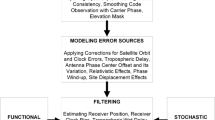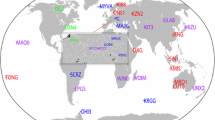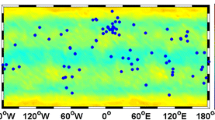Abstract
The performance of multi-GNSS (GPS/Galileo) Single-Frequency Precise Point Positioning (SF-PPP) is studied for both static and kinematic PPP users. In the underlying multi-epoch model, the user ambiguities are assumed constant in time, while the positioning parameters are treated as constant (the static case) and fully unlinked in time (the kinematic case). To demonstrate the quality of single-frequency PPP-aided by European Galileo system besides GPS, experimental datasets of Victoria permanent GNSS network which is a sub-network of ARGN (Australian Regional GNSS Network) are analyzed using self-developed software routines. It is shown how Galileo system can enhance the SF-PPP performance as compared to GPS-only single-frequency for high grade geodetic receivers. Our numerical results demonstrate that multi-GNSS SF-PPP outperforms GPS-only in kinematic mode in terms of positioning accuracy. The standard deviation (STD) values of the positioning errors for multi-GNSS/GPS-only solutions are within 2 mm/4 mm (horizontal) and 4 mm/10 mm (vertical). The root-mean-squared error (RMS) values are also within 10 mm/10 mm (horizontal) and 35 mm/50 mm (vertical).













Similar content being viewed by others
References
Afifi A, El-Rabbany A (2015) Performance analysis of several GPS/Galileo precise point positioning models. Sensors 15:14701–14726. https://doi.org/10.3390/s150614701
Choy SL (2009) An investigation into the accuracy of single frequency precise point positioning (PPP). Thesis (PhD) in School of Mathematical and Geospatial Sciences College of Science, Engineering and Health, RMIT University
de Bakker PF, Tiberius CCJM (2017) Real-time multi-GNSS single-frequency precise point positioning. GPS Solut 21:1791–1803
Eueler HJ, Goad C (1991) On optimal filtering of GPS dual frequency observations without using orbit information. BullGéod 65(2):130–143
Escribano MG (2017) E1 Galileo signal receiver. Thesis Submitted to the Faculty of Escola Tècnica dÉEnginyeria de Telecomunicació de Barcelona, Universitat PolitTècnica de Catalunya
Hofmann-Wellenhof B, Lichtenegger H, Wasle E (2008) GNSS: global navigation satellite systems: GPS, glonass, Galileo and more. Springer, New York
Jwo DJ, Lai CN (2008) Unscented Kalman filter with nonlinear dynamic process modeling for GPS navigation. GPS Solut 12:249–260. https://doi.org/10.1007/s10291-007-0081-9
Kaplan ED (1996) Understanding GPS: Principles and applications. Artech House, p 556
Khodabandeh A (2014) Array-aided single-differenced satellite phase bias determination: methodology and results. Proceedings of the 27th International Technical Meeting of the ION Satellite Division ION GNSS+ 2014, Tampa, Florida
Kouba J, Heroux P (2001) GPS precise point positioning using IGS orbit products. GPS Solution 5(2):12–28. https://doi.org/10.1007/PL00012883
Liu T, Yuan Y, Zhang B, Wang N, Tan B, Chen Y (2016) Multi-GNSS precise point positioning (MGPPP) using raw observations. J Geod 91:253–268. https://doi.org/10.1007/s00190-016-0960-3
Nie Z, Liu F, Gao Y (2020) Real-time precise point positioning with a low-cost dual-frequency GNSS device. GPS Solut https://doi.org/10.1007/s10291-019-0922-3
Nobakht-Ersi F, Safari A (2020) Single point positioning performance of single-frequency code-based mode with ionospheric modelling: a case study over Iran. J Spatial Sci: 1–22. https://doi.org/10.1080/14498596.2020.1835567
Odijk D (2002) Fast precise GPS positioning in the presence of ionospheric delays. In: Publications on geodesy, 52, Netherlands Geodetic Commission, Delft, The Netherlands
Odijk D, Teunissen PJG, Khodabandeh A (2014) Single-frequency PPP-RTK: Theory and experimental results. International Association of Geodesy Symposium (IAG) 139:167–173. Springer
Odijk D, Teunissen PJG, Zhang B (2012) Single-frequency integer ambiguity resolution enabled GPS precise point positioning. J Surv. Eng 138(4):193–202. https://doi.org/10.1061/(ASCE)SU.1943-5428.0000085
Odolinski R, Teunissen PJG, Odijk D (2014) Combined BDS, Galileo, QZSS and GPS single-frequency RTK. GPS Solut, https://doi.org/10.1007/s10291-014-0376-6
Odolinski R, Teunissen PJG (2017) Low-cost, high-precision, single-frequency GPS-BDS RTK positioning. GPS Solut 21:1315–1330. https://doi.org/10.1007/s10291-017-0613-x
Odolinski R, Teunissen PJG (2020) Best integer equivariant estimation: performance analysis usingreal data collected by low-cost, single- and dual- frequency, multi-GNSS receivers for short- to long-baselineRTK positioning. J Geod 94:91. https://doi.org/10.1007/s00190-020-01423-2
Paziewski J, Wielgosz P (2015) Accounting for Galileo-GPS inter-system biases in precise satellite positioning. J Geod 89:81–93. https://doi.org/10.1007/s00190-014-0763-3
Petrovski IG (2014) GPS, GLONASS, Galileo, and BeiDou for mobile devices. Cambridge University Press, Cambridge
Rovira-Garcia A, Juan JM, Sanz J, Gonzàlez-Casado G, Bertran E (2016) Fast precise point positioning: A system to provide corrections for single and Multi-frequency navigation. Journal of The Institute of Navigation 63(3):231–247
Teunissen PJG, Kleusberg A (1998) GPS for geodesy, 2nd edn. Springer, Berlin
Teunissen PJG (2000) Testing theory; an introduction, Delft University Press
Teunissen PJG, Khodabandeh A (2019) GLONASS ambiguity resolution. GPS Solutions 23(101). https://doi.org/10.1007/s10291-019-0890-7
Verhagen S (2005) The GNSS integer ambiguities: estimation and validation. Thesis (PhD), Delft Univ of Technology, Delft, The Netherlands
Witchayangkoon B (2000) Elements of GPS precise point positioning Thesis (PhD) in Spatial Information Science and Engineering, The Graduate School, The University of Maine
Acknowledgments
The authors wish to acknowledge the Geoscience Australia of Australian Government that provided the data for evaluation in this paper.
Author information
Authors and Affiliations
Corresponding author
Additional information
Communicated by: H. Babaie
Publisher’s note
Springer Nature remains neutral with regard to jurisdictional claims in published maps and institutional affiliations.
Rights and permissions
About this article
Cite this article
Nobakht-Ersi, F., Safari, A. Multi-GNSS (GPS/Galileo) single-frequency precise point positioning: a case study over Victoria. Earth Sci Inform 14, 1303–1313 (2021). https://doi.org/10.1007/s12145-021-00663-w
Received:
Accepted:
Published:
Issue Date:
DOI: https://doi.org/10.1007/s12145-021-00663-w




